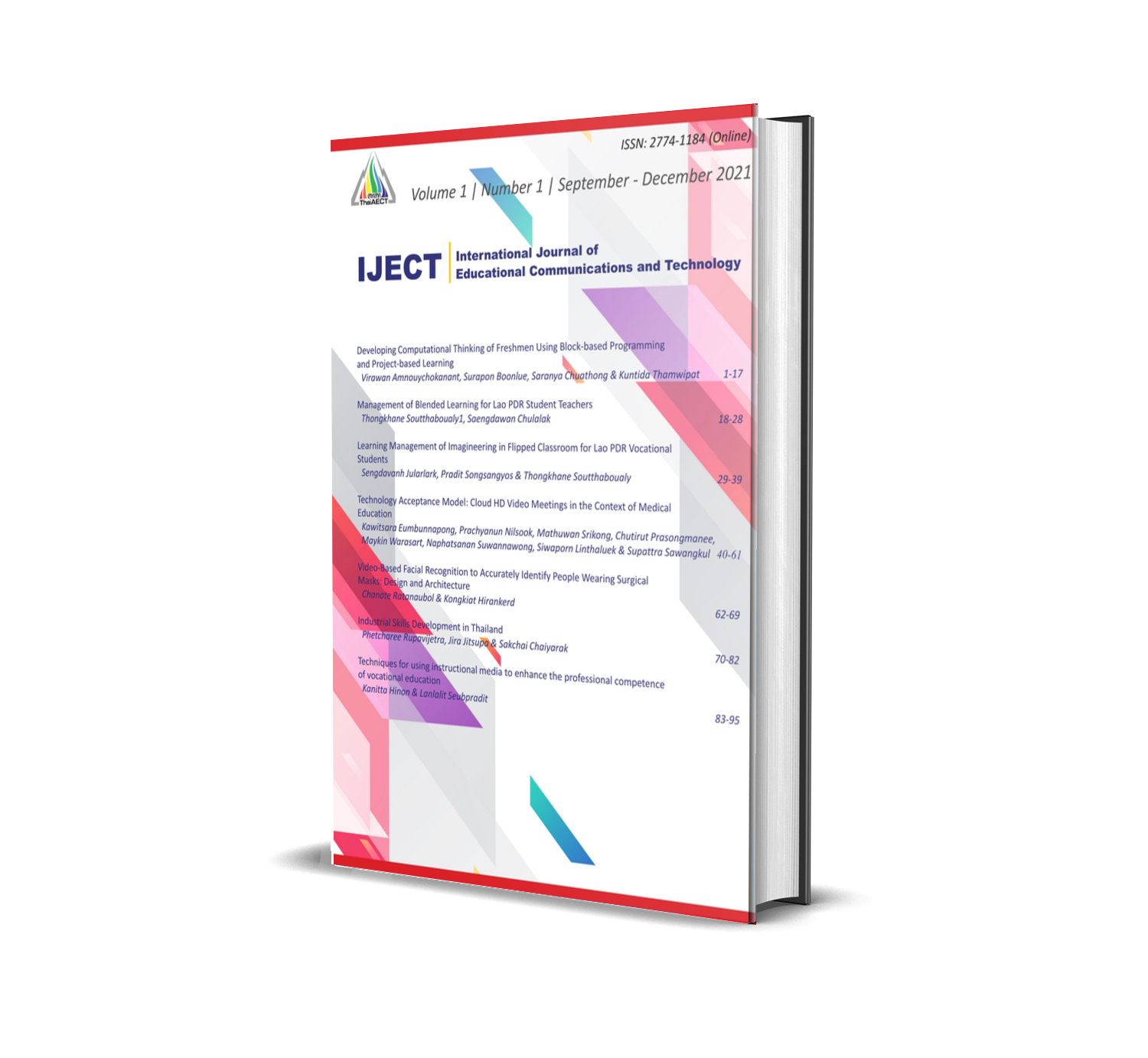Speculative Plausible Future Design of an AI eLearning Application for a Vocational Institution in Tokyo
Keywords:
Artificial Intelligent eLearning Application, Augmenting Space, English Conversation Skill, Plausible Futures, Speculative Design, Vocational Institution, TokyoAbstract
This study applied a speculative design concept to define a cone of plausible futures for Artificial intelligence (AI) eLearning application of English conversational skills installed by 1,229 students at a vocational institution in Tokyo, Japan. The AI eLearning application was designed to give students an immersive learning experience in an augmented learning space that would have been difficult to realize in physical space since the COVID-19 pandemic. The input for the assessment of the plausible future was in-depth interview results from 25 students and teachers, with the subsequent analysis conducted using framework foresight. The key was to determine a definition for a cone of plausible futures and define the plausibility limits for the baseline, alternative and preferred futures. This paper describes how the speculative design concept was applied to the AI eLearning application to transform the created cone of plausible future findings into practical implementation goals. Education potential in the post COVID-19 pandemic needs to adopt augmented learning space by applying the power of multiple technologies based on computer artificial intelligence.
References
Asare, A. O., Yap, R., Truong, N., & Sarpong, E. O. (2021). The pandemic semesters: Examining public opinion regarding online learning amidst COVID-19. Journal of Computer Assisted Learning, s(s). https://doi.org/10.1111/jcal.12574
Coulton, P., Burnett, D., & Gradinar, A. I. (2016). Games as speculative design: Allowing players to consider alternate presents and plausible futures. Proceedings of Design Research Society Conference 2016, 1609–1626. https://doi.org/10.21606/drs.2016.15
Duggan, S. (2020). AI in Education: Change at the Speed of Learning. The UNESCO Institute for Information Technologies in Education.
Dunne, A., & Raby, F. (2013). Speculative everything: Design, fiction, and social dreaming. MIT press. http://www.books24x7.com/marc.asp?bookid=57537
Goh, H.-H., & Vinuesa, R. (2021). Regulating artificial-intelligence applications to achieve the sustainable development goals. Discover Sustainability, 2(1), 52. https://doi.org/10.1007/s43621-021-00064-5
Gordon, M., & Burgess, M. (2020). The hidden impact of COVID-19 on children’s education. UNESCO. https://healtheducationresources.unesco.org/library/documents/hidden-impact-covid-19-childrens-education
Hato, Y. (2006). Mechanism of “able to speak” for those who learn or teach English 英語を学ぶ人・教える人のために. Sekaishisosha.
Hines, A., & Bishop, P. C. (2013). Framework foresight: Exploring futures the Houston way. Futures, 51, 31–49. https://doi.org/10.1016/j.futures.2013.05.002
Jespersen, S. (2022). Advocating for an 18th Sustainable Development Goal: A Meaningful and Safe Digital Life. Vertic.Com. https://vertic.com/our-thinking/advocating-for-an-18th-sustainable-development-goal-a-meaningful-and-safe-digital-life
Johannessen, L. K., Keitsch, M. M., & Pettersen, I. N. (2019). Speculative and Critical Design—Features, Methods, and Practices. Proceedings of the Design Society: International Conference on Engineering Design, 1(1), 1623–1632. https://doi.org/10.1017/dsi.2019.168
Lombardo, G. (2022, January 20). 8 Spectacular Speculative Designs That Will Blow Your Mind. DeMagSign. https://medium.com/demagsign/8-spectacular-speculative-designs-44fb129eb4e2
Malpass, M. (2017). Critical design in context: History, theory, and practices. Bloomsbury Academic, an imprint of Bloomsbury Publishing Plc.
Manovich, L. (2006). The poetics of augmented space. Visual Communication, 5(2), 219–240. https://doi.org/10.1177/1470357206065527
Mitrović, I. (2015). Introduction to Speculative Design Practice. Speculative. http://speculative.hr/en/introduction-to-speculative-design-practice/
Parker, C. (2018). Augmenting Space: Design approaches for making public interactive displays relevant in hyperconnected societies [Sydney School of Architecture, Design and Planning, The University of Sydney]. https://www.researchgate.net/profile/Callum-Parker-2/publication/329578247_Augmenting_Space_Design_approaches_for_making_public_interactive_displays_relevant_in_hyperconnected_societies/links/5c1055baa6fdcc494fed9398/Augmenting-Space-Design-approaches-for-making-public-interactive-displays-relevant-in-hyperconnected-societies.pdf
Peace, E. (2019, July 25). Speculative design for the real world. Medium. https://uxdesign.cc/speculative-design-for-the-real-world-551130b22827
Purdy, M., & Daugherty, P. (2022, June 8). Artificial Intelligence is the Future of Growth. Accenture Canada. https://www.accenture.com/ca-en/insight-artificial-intelligence-future-growth-canada
Sedaghat-Baghbani, M. (2021). Designing Products of the Future Through Speculative Design. Design Incubation Colloquium, 7(3). https://designincubation.com/publications/abstracts/designing-products-of-the-future-through-speculative-design/
Stansberry, K., Anderson, J., & Rainie, L. (2019). 4. The internet will continue to make life better. Pew Research Center: Internet, Science & Tech. https://www.pewresearch.org/internet/2019/10/28/4-the-internet-will-continue-to-make-life-better/
Sustainability in the Digital Age. (2019). Montreal Statement | Sustainability in the Digital Age. https://sustainabilitydigitalage.org/montreal-statement/
Takahashi, Y. (2020). Redesigning an artificial intelligence elearning application to improve Japanese students’ English conversational skills: A case study of a vocational institute in Tokyo, Japan [ELearning Methodology, Assumption University]. https://repository.au.edu/handle/6623004553/24481
Takahashi, Y., & Vate-U-Lan, P. (2019). Toward Understanding the Impact of Artificial Intelligence on Education: An Empirical Research in Japan. The European Conference on the Impact of Artificial Intelligence and Robotics ECIAIR 2019, 433–440. https://doi.org/10.34190/ECIAIR.19.091
The MindFuture Foundation. (2020). Life with Artificials Introducing the 18th Sustainable Development Goal. https://mindfuture.ai/wp-content/uploads/2020/10/Life-with-Artificials-18th-rev-21.10.2020-FINAL.pdf
Tonkinwise, C. (2014). How we intend to future: Review of Anthony Dunne and Fiona Raby, speculative everything: design, fiction, and social dreaming. Design Philosophy Papers, 12(2), 169–187. https://doi.org/10.2752/144871314X14159818597676
Tran, T. H. (2019, April 8). Speculative design: 3 examples of design fiction. Inside Design. https://www.invisionapp.com/inside-design/speculative-design/
Tsekleves, E., Yong, M. H., Lee, C. A. L., Giga, S., Hwang, J. S., & Lau, S. L. (2019). Rethinking how healthcare is conceptualised and delivered through speculative design in the UK and Malaysia: A Comparative study. The Design Journal, An International Journal for All Aspects of Design, 22(sup1), 429–444. https://doi.org/10.1080/14606925.2019.1595430
United Nations. (2021). The Sustainable Development Goals Report 2020 (pp. 1–68). United Nations. https://unstats.un.org/sdgs/report/2020/The-Sustainable-Development-Goals-Report-2020.pdf
Van der Helm, R. (2006). Towards a clarification of probability, possibility and plausibility: How semantics could help futures practice to improve. Foresight, 8(3), 17–27. https://doi.org/10.1108/14636680610668045
van Duijne, F., & Bishop, P. (2018). Introduction to strategic foresight (Vol. 1). Future Motion. https://www.futuremotions.nl/wp-content/uploads/2018/01/FutureMotions_introductiondoc_January2018.pdf
Voros, J. (2017, February 24). The Futures Cone, use and history. The Voroscope. https://thevoroscope.com/2017/02/24/the-futures-cone-use-and-history/
Downloads
Published
How to Cite
Issue
Section
License
Copyright (c) 2023 International Journal of Educational Communications and Technology

This work is licensed under a Creative Commons Attribution-NonCommercial-NoDerivatives 4.0 International License.







